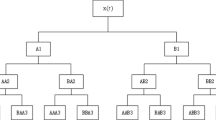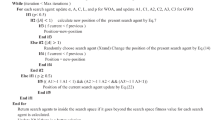Abstract
A novel classification method based on ICGOA-KELM is presented in this paper. In ICGOA-KELM, an improved circle chaotic map with grasshopper optimization algorithm (ICGOA) is designed to optimize the parameters of Kernel extreme learning machine (KELM) to improve the stability and accuracy of fault classification for rolling bearing based on parameter modification of circle chaotic map. Grasshopper optimization algorithm (GOA) is a new heuristic optimization algorithm, which has strong global searching ability. However, it still may fall into local optimization in some cases. In this paper, the vibration signals of rolling bearing are preprocessed by using Variational Modal Decomposition (VMD). Then Multi-scale Permutation Entropy (MPE) is utilized to extracted features of intrinsic mode functions (IMFs) decomposed by VMD. In addition, KPCA is adopted to select the salient features with high contribution rates to remove redundant and irrelevant features. Finally, the salient features are fed into ICGOA-KELM to fulfill fault classification. Therefore, a new fault detection and classification method based on VMD, MPE, KPCA and ICGOA-KELM is proposed. This method is applied to the fault classification of rolling bearing and the identification of different damage fault degrees. Experiments verify that the proposed method is more effective than CGOA-KELM for fault diagnosis of rolling bearing.















Similar content being viewed by others
References
Li Y, Xu M, Wang R, Huang W (2016) A fault diagnosis scheme for rolling bearing based on local mean decomposition and improved multiscale fuzzy entropy[J]. J Sound Vib 360:277–299
Zhou F, Yang S, Fujita H, Chen D, Wen C (2020) Deep learning fault diagnosis method based on global optimization GAN for unbalanced data[J]. Knowl-Based Syst 187:104837
Wang D (2016) K-nearest neighbors based methods for identification of different gear crack levels under different motor speeds and loads: revisited[J]. Mech Syst Signal Process 70:201–208
Al-Raheem KF, Abdul-Karem W (2010) Rolling bearing fault diagnostics using artificial neural networks based on Laplace wavelet analysis[J]. Int J Eng Sci Technol 2(6):278–290
Baraldi P, Podofillini L, Mkrtchyan L, Zio E, Dang VN (2015) Comparing the treatment of uncertainty in bayesian networks and fuzzy expert systems used for a human reliability analysis application. Reliab. Eng. Syst. Saf. 138:176–193
Yan X, Jia M (2018) A novel optimized SVM classification algorithm with multi-domain feature and its application to fault diagnosis of rolling bearing[J]. Neurocomputing 313:47–64
Liu R, Yang B, Zio E, Chen X (2018) Artificial intelligence for fault diagnosis of rotating machinery: a review[J]. Mech Syst Signal Process 108:33–47
Huang GB, Zhu QY, Siew CK (2004) Extreme learning machine: a new learning scheme of feedforward neural networks. Proc. IEEE Int. jt. Conf. Neural Netw 2:985–990
Sun ZL, Choi TM, Au KF, Yu Y (2008) Sales forecasting using extreme learning machine with applications in fashion retailing. Decis. Support Syst 46:411–419
Liang NY, Saratchandran P, Huang GB, Sundararajan N (2006) Classification of mental tasks from EEG signals using extreme learning machine. Int. J. Neural Syst 16:29–38
Mohammed AA, Minhas R, Wu QJ, Sid-Ahmed MA (2011) Human face recognition based on multidimensional PCA and extreme learning machine. Pattern Recogn 44:2588–2597
Huang GB, Zhu QY, Siew CK (2006) Extreme learning machine: theory and applications. Neurocomputing 70:489–501
Huang GB (2014) An insight into extreme learning machines: random neurons, random features and kernels[J]. Cogn Comput 6(3):376–390
Rodriguez N, Barba L, Alvarez P, Cabrera-Guerrero G (2019) Stationary wavelet-Fourier entropy and kernel extreme learning for bearing multi-fault diagnosis [J]. Entropy 21(6):540
Saremi S, Mirjalili S, Lewis A (2017) Grasshopper optimisation algorithm: theory and application[J]. Adv Eng Softw 105:30–47
Hamad A, Houssein EH, Hassanien AE, Fahmy AA (2018) Hybrid grasshopper optimization algorithm and support vector machines for automatic seizure detection in EEG signals. In International Conference on Advanced Machine Learning Technologies and Applications, Springer, Cairo pp. 82–91
Mirjalili SZ, Mirjalili S, Saremi S, Faris H, Aljarah I (2018) Grasshopper optimization algorithm for multi-objective optimization problems[J]. Appl Intell 48(4):805–820
Zhang X, Miao Q, Zhang H, Wang L (2018) A parameter-adaptive VMD method based on grasshopper optimization algorithm to analyze vibration signals from rotating machinery[J]. Mech Syst Signal Process 108:58–72
Li Y, Xu M, Wei Y, Huang W (2016) A new rolling bearing fault diagnosis method based on multiscale permutation entropy and improved support vector machine based binary tree[J]. Measurement 77:80–94
Kumar A, Kumar R (2019) Role of signal processing, modeling and decision making in the diagnosis of rolling element bearing defect: a review[J]. J Nondestruct Eval 38(1):5
Feng Z, Liang M (2013) Chu F. recent advances in time–frequency analysis methods for machinery fault diagnosis: a review with application examples, Mech. Syst. Signal Process 38(1):165–205
Dragomiretskiy K, Zosso D (2014) Variational mode decomposition[J]. IEEE Trans Signal Process 62(3):531–544
Huang NE, Shen Z, Long SR, Wu MC, Shih HH, Zheng Q et al (1998) The empirical mode decomposition and the Hilbert spectrum for nonlinear and non-stationary time series analysis. Proc. R. Soc. Lond. A 454:903–995
Wu Z, Huang NE (2009) Ensemble empirical mode decomposition: a noise-assisted data analysis method[J]. Adv Adapt Data Anal 1(01):1–41
Aziz W , Arif M. Multiscale permutation entropy of physiological time series[C]// 9th international multitopic conference, IEEE INMIC 2005. IEEE, 2006
Pincus M (1991) Approximate entropy as a measure of system complexity. Proc Natl Acad Sci 88:2297–2301
Yan RQ, Gao RX (2007) Approximate entropy as a diagnostic tool for machine health monitoring. Mech. Syst. Signal Process 21:824–839
Bandt C, Pompe B (2002) Permutation entropy: a natural complexity measure for time series[J]. Phys Rev Lett 88(17):174102
Schölkopf B, Smola A, Müller KR (1997) Kernel principal component analysis[C]//international conference on artificial neural networks. Springer, Berlin, pp 583–588
Jiang LL, Deng ZQ, Tang SW (2011) KPCA Denoising and its application in machinery fault diagnosis[J]. Appl Mech Mater 103:274–278
Zheng WM (1994) Kneading plane of the circle map[J]. Chaos, Solitons Fractals 4(7):1221–1233
Arora S, Anand P (2018) Chaotic grasshopper optimization algorithm for global optimization[J]. Neural Comput & Applic:1–21
Wang Y, Xiangfeng S, Ming L (2010) Training method of support vector machine based on Chaos particle swarm optimization [J]. Comput Eng 36(23):189–191
Chen D, Zhang Y, Yao C, Lai B, Lv S (2017) Fault diagnosis based on variational modal decomposition and multiscale permutation entropy [J]. Computer Integrated Manufact Syst 12:47–55
Zheng J, Pan H, Yang S, Cheng J (2018) Generalized composite multiscale permutation entropy and Laplacian score based rolling bearing fault diagnosis[J]. Mech Syst Signal Process 99:229–243
Li Y, Xu M, Wei Y, Huang W (2016) A new rolling bearing fault diagnosis method based on multiscale permutation entropy and improved support vector machine based binary tree[J]. Measurement 77:80–94
Zhang Q, Gao J, Dong H, Mao, Y. WPD and DE/BBO-RBFNN for solution of rolling bearing fault diagnosis[J]. Neurocomputing, 2018: S0925231218305459
Li Y, Zhang W (2017) Qing Xiong. A rolling bearing fault diagnosis strategy based on improved multiscale permutation entropy and least squares SVM[J]. J Mech Sci Technol 31(6):2711–2722
Brkovic A, Gajic D (2017) Early fault detection and diagnosis in bearings for more efficient operation of rotating machinery. Energy 136:63–71
Udmale SS, Singh SK (2019) Application of spectral kurtosis and improved extreme learning machine for bearing fault classification[J]. IEEE Trans Instrum Meas
Stalin S (2014) Fault diagnosis and automatic classification of roller bearings using time-domain features and artificial neural network[J]. Int J Sci Research (IJSR) 3:824–851
Chen Y, Zhang T, Luo Z, Sun K (2019) A novel rolling bearing fault diagnosis and severity analysis method[J]. Appl Sci 9(11):2356
Acknowledgements
This work was supported by the National Natural Science Foundation of China (NO.61763029, 61873116), the Open Foundation of State Key Laboratory of Large Electric Drive System and Equipment Technology (No. SKLLDJ012016020), the Industrial support and guidance project of colleges and universities of Gansu Province (No. 2019C-05) and the open fund project of Key Laboratory of Gansu Advanced Control for Industrial Processes (No. 2019KFJJ01). The authors would like to thank Case Western Reserve University for providing motor bearing vibration data.
Author information
Authors and Affiliations
Corresponding author
Additional information
Publisher’s note
Springer Nature remains neutral with regard to jurisdictional claims in published maps and institutional affiliations.
Rights and permissions
About this article
Cite this article
Chen, P., Zhao, X. & Zhu, Q. A novel classification method based on ICGOA-KELM for fault diagnosis of rolling bearing. Appl Intell 50, 2833–2847 (2020). https://doi.org/10.1007/s10489-020-01684-6
Published:
Issue Date:
DOI: https://doi.org/10.1007/s10489-020-01684-6




